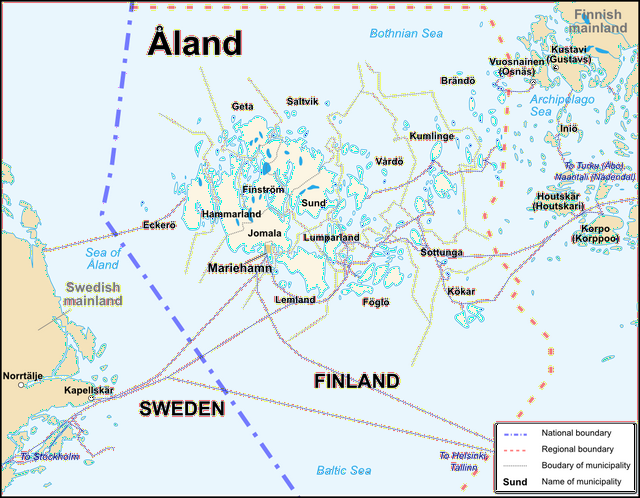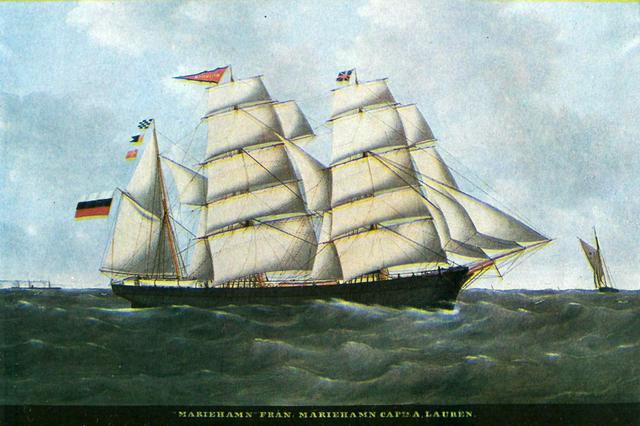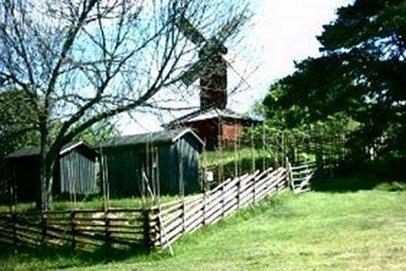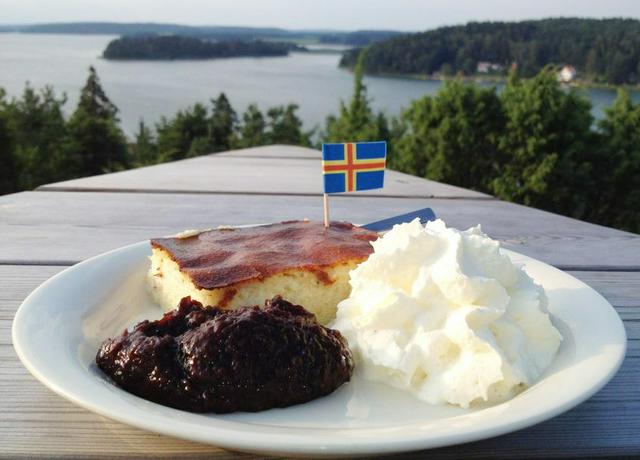The Åland Islands in the Baltic Sea have extensive maritime history, warm, sunny weather (compared to the rest of the region), and popular outdoor activities. Consisting of a main island and a surrounding archipelago, Åland is legally a part of Finland, but in practice the islands run their own affairs and are rather different from the mainland. As the less than 30,000 inhabitants speak Swedish, the province's Finnish name Ahvenanmaa is rarely used.
Åland is divided into 15 municipalities and one city, Mariehamn. Most municipalities consist of an island group and surrounding archipelago, though a couple are on the "main island" (which in fact consists of a few islands, separated by narrow sounds and connected by bridges).
- Mariehamn (Finnish: Maarianhamina), the capital
Reachable without ferry:
- Eckerö – ferry port in the west, with a giant post office house
- Finström
- Geta
- Hammarland
- Jomala
- Lemland
- Lumparland
- Saltvik
- Sund
Archipelago municipalities:
- Brändö – bordering the northern mainland archipelago
- Föglö
- Kumlinge
- Kökar – island in the south-east, along the ancient fairway; monastery ruins
- Sottunga – smallest municipality in Finland, with about a hundred inhabitants
- Vårdö

The Åland Islands (pronounced [ˈoːland]) are a group of small islands officially belonging to Finland but awarded a wide degree of autonomy by a League of Nations decision in 1921, which settled a long-running dispute between Sweden and Finland. Still at the time when Åland was under Russian sovereignty, a treaty was concluded between Russia, France and the United Kingdom at the issue of the Crimean War, by virtue of which the islands were demilitarized. Finland assumed the same obligation upon achieving independence. Among other things, Ålanders have their own parliament, issue their own stamps, are exempt from military service and maintain a special tax status in the European Union.
The archipelago consists of around 80 inhabited islands plus around 6,000 uninhabited islands, islets and rocks. The total population is only 30,000 (2019), 90% of which lives on the main island, known as Fasta (Mainland) Åland, which includes the capital Mariehamn. In local documents "the archipelago" does not include the main island.
Use care when planning activities or relying on community services. Outside Mariehamn the communities are tiny; what looks like a town on the map may be a village of only a few buildings at a cross roads!
In winter many guesthouses, cottage villages and sights (such as Pommern and Kastelholm) are closed. There is not much snow; opportunities for winter sports are limited.

Since a long time seafaring has been important for Åland. In old times trade with the capital Stockholm dominated (and visiting ships on their way to Finland or Russia), but when regulations were eased, the Ålanders, who are quick to entrepreneurship, built bigger vessels – probably the densest ship ownership worldwide – and in the late 19th century they sailed out on the ocean with ships built with the accumulated wealth. "Captain's/shipowner's mansions" all over the islands remind of the epoch.
Around the turn of the century, when the rest of the world was converting to steam, many shipowners made bargains, buying good sailing ships for scrap prices. The last and most well-known, Gustaf Erikson, owned most ocean going sailing ships left in the 1930s. When the age of sail definitively was over, there were several shipowner companies, some of which still remain.
The islands are monolingually Swedish, a point of some contention in otherwise bilingual (or, in practice, frequently Finnish monolingual) Finland. This goes both ways: the Ålanders did not choose to be part of Finland and are often upset by the way their language is forgotten by mainland authorities.
Although Finnish is optionally taught in schools, many Ålanders choose not to study it and some may not want to speak it even if they know it. English is very widely spoken, even by many elderly people, and would be the primary choice if you can't speak Swedish or something closely related to it.
Signs are sometimes bilingual in Swedish and English or Swedish and Finnish, but English or even rudimentary Swedish usually make a better start than Finnish. If your Swedish and English are weak and Finnish seems a good choice, start with Swedish anyway and let the local make the choice about changing languages. Tourism is big, many of the tourists are Finnish and Ålanders know service in Finnish is a bonus, so many struggle to be able to offer it.
Note many major tourist spots are only open during late spring and summer and during closed times can only be viewed from the outside.
- Kastelholm. A castle located in the northern part is worth paying a visit. Partly a ruin today, it was founded in the 1380s. There are guided tours, also in English.
- Jan Karlsgarden Open Air Museum. Very close to Kastelholm castle, it has a number of traditional Åland buildings moved from other areas. Entry was free in 2008, although a fee was charged to visit the prison museum on the same site. Also has a tourist information center and a good restaurant and cafeteria.

- Bomarsund Fortress. Was built by the Russians during the years 1830-1854. The establishment was thoroughly ruined during the Crimean War when attacked by the allied English-Frenchmen. On the other side of the channel, next to the bridge of Prästö, is a small museum where pictures and objects from Bomarsund are on display.
- Postvägen. The Mail Route dates back to Queen Kristina´s days in the 17th century, when the Swedish postal service of that time was organized. Today the Mail Road looks different but it is still very much alive.
- 4-mb POMMERN and Maritime museum. In the West Harbour in Mariehamn serves as a memory of the great fleet of sailing ships that once had the town as their homeport. Her owner, Gustaf Erikson, had many similar ships on the Australian grain trade, the last ones, Passat and Pamir, rounding Cape Horn in 1949, long after the rest of the world had changed to steam and motor. Major repairs were conducted 2017–2018 and the ship is now accessible also to the mobility impaired.
- Aland hunting and fishing museum, Fiskeläge 37, +358 18 38 299. 10-17. Museum about everyday life on the fishing villages as well as hunters and fishermen in Åland. Open mid-May to the end of August. adults €7, children 7-17yo €4, children under 6yo free.
- Eckerö Mail and Customs House, Sandmovägen 111, +358 457 530 1435. daily 10-18. A historical building that served as a mail and customs office. Built 1828 it is considered as one of the most impressive work of its architechts and together with the Bomarsund fortress as most important buildings from the Russian era. Café. Open mid-May to early September. free.
- Brewery Stallhagen, Getavägen 196, + 358 457 344 8500. A brewery with guided tours, own pub and an outlet store.
- Franciscan monastery ruins, Hamnö. Ruins of once powerful medieval Franciscan monastery. Free entry exhibition about the history and archaeological excavations. Culture trail. free.
- Make a day trip to a lighthouse. During the summer season there are guided tours to Lågskär lighthouse. in the south, Sälskär lighthouse. in the north, and Märket lighthouse. in the west.
Kastelholm. A castle located in the northern part is worth paying a visit. Partly a ruin today, it was founded in the 1380s. There are guided tours, also in English.
Jan Karlsgarden Open Air Museum. Very close to Kastelholm castle, it has a number of traditional Åland buildings moved from other areas. Entry was free in 2008, although a fee was charged to visit the prison museum on the same site. Also has a tourist information center and a good restaurant and cafeteria.
Bomarsund Fortress. Was built by the Russians during the years 1830-1854. The establishment was thoroughly ruined during the Crimean War when attacked by the allied English-Frenchmen. On the other side of the channel, next to the bridge of Prästö, is a small museum where pictures and objects from Bomarsund are on display.
Postvägen. The Mail Route dates back to Queen Kristina´s days in the 17th century, when the Swedish postal service of that time was organized. Today the Mail Road looks different but it is still very much alive.
4-mb POMMERN and Maritime museum. In the West Harbour in Mariehamn serves as a memory of the great fleet of sailing ships that once had the town as their homeport. Her owner, Gustaf Erikson, had many similar ships on the Australian grain trade, the last ones, Passat and Pamir, rounding [[Tierra del Fuego (Chile)|Cape Horn]] in 1949, long after the rest of the world had changed to steam and motor. Major repairs were conducted 2017–2018 and the ship is now accessible also to the mobility impaired.
Aland hunting and fishing museum, Fiskeläge 37, +358 18 38 299. 10-17. Museum about everyday life on the fishing villages as well as hunters and fishermen in Åland. Open mid-May to the end of August. adults €7, children 7-17yo €4, children under 6yo free.
Eckerö Mail and Customs House, Sandmovägen 111, +358 457 530 1435. daily 10-18. A historical building that served as a mail and customs office. Built 1828 it is considered as one of the most impressive work of its architechts and together with the Bomarsund fortress as most important buildings from the Russian era. Café. Open mid-May to early September. free.
Brewery Stallhagen, Getavägen 196, + 358 457 344 8500. A brewery with guided tours, own pub and an outlet store.
Franciscan monastery ruins, Hamnö. Ruins of once powerful medieval Franciscan monastery. Free entry exhibition about the history and archaeological excavations. Culture trail. free.
Make a day trip to a lighthouse. During the summer season there are guided tours to Lågskär lighthouse. in the south, Sälskär lighthouse. in the north, and Märket lighthouse. in the west.
Make a day trip to a lighthouse. During the summer season there are guided tours to Lågskär lighthouse. in the south, Sälskär lighthouse. in the north, and Märket lighthouse. in the west.
Make a day trip to a lighthouse. During the summer season there are guided tours to Lågskär lighthouse. in the south, Sälskär lighthouse. in the north, and Märket lighthouse. in the west.
Åland is great for outdoor life; hiking, bathing, and enjoying the silent countryside. The right to access is not as liberal as in mainland Finland or Sweden; read more details.
The fishing law is different from that of mainland Finland. For fishing, you need a permit from the owner of the waters, available for many locations by paying a fee. Many small businesses arrange fishing excursions or rent boat and equipment. They can probably handle the permits and show where to fish. Some fishing far from privately owned islands is free for Nordic residents.
The official currency is the euro (€). Swedish krona (SEK) is usually accepted in most shops and restaurants during the peak season, but the exchange rate is typically not very good, so it is significantly cheaper to pay in euros or by card. Compare rates with local banks first.
Shopping in Åland is expensive. Due to import of most goods, prices in most stores are in the EU highs, mostly 10–50 percent higher than in the Stockholm or Helsinki metropolitan areas. Prices on some groceries can be even higher, with oatmeal and gruel selling at more than double the price in, say, Stockholm or Helsinki.
As in other Nordic countries, international credit cards, at least VISA and Mastercard, are commonly accepted.
SALT in the maritime district of the east harbor of Mariehamn has a selection of local artisan crafts including textiles and glassware made in Åland, next to a maritime museum and local jewellery shop.
Åland has its own postal service and stamps unique to the island, these make excellent inexpensive souvenirs. There are post offices in several villages and in Mariehamn.
In general, souvenir shopping in Åland is difficult. The island is not well presented for international tourists and there are often only small displays of the typical souvenirs such as keychains, postcards and mugs. A few of the stores along Torggatan in downtown Mariehamn have these, as well as museums and some of the larger grocery stores. Some museums offer more special things, and local handicraft can be found at some locations.
Local beer, apple juice and apple liquors are tasty and available (Åland produces a third of Finland's apples).

Some food items to look for:
- Smoked flounder with potato salad and fish dishes in general.
- Svartbröd, blackbread, as the name implies the bread is almost black. It is a round and quite flat rye bread. Its most characteristic feature is the taste. The blackbread is sweet. The sweetness originates from the treacle that is added to the dough and from the manner in which the bread is baked in the oven (baking blackbread is a time-consuming procedure). Stored cool the bread stays good for weeks, even months. It was originally used (in a less sweet version) on long fishing, hunting or seafaring expeditions.
- Cheese from the local ÅCA dairy is of high quality. The Kastelholm cheese is particularly recommended, and works well with blackbread. Its roots can be traced back to the 16th century.
- Ålands pancake, a traditional and delicious Ålands dessert. The pancake is made from rice or semolina porridge, flavoured with sugar, salt, cardamom powder and vanilla, and is served with stewed plums and whipped cream.
Most restaurants are in Mariehamn. Do not expect to find fast food outlets elsewhere on the islands. Some restaurants have limited hours of service and some are not open every day. Guest houses can usually arrange dinner, but you might have to book it beforehand.
Smoked flounder with potato salad and fish dishes in general.
Svartbröd, blackbread, as the name implies the bread is almost black. It is a round and quite flat rye bread. Its most characteristic feature is the taste. The blackbread is sweet. The sweetness originates from the treacle that is added to the dough and from the manner in which the bread is baked in the oven (baking blackbread is a time-consuming procedure). Stored cool the bread stays good for weeks, even months. It was originally used (in a less sweet version) on long fishing, hunting or seafaring expeditions.
Cheese from the local ÅCA dairy is of high quality. The Kastelholm cheese is particularly recommended, and works well with blackbread. Its roots can be traced back to the 16th century.
Ålands pancake, a traditional and delicious Ålands dessert. The pancake is made from rice or semolina porridge, flavoured with sugar, salt, cardamom powder and vanilla, and is served with stewed plums and whipped cream.
While ships docking at Åland offer duty-free shopping, alcohol prices on Åland itself are on par with Sweden and Finland, and the tax free prices only somewhat cheaper.
-
Stallhagen beer made by Ålands Bryggeri AB and available in most bars and restaurants in the islands. The most common Stallhagen beer type is the traditional, light lager. But Stallhagen also comes in a wide range of other beer types with names like Dark Lager, Dunkles, Oktoberfest and Delicat. And there's no doubt where it comes from: the flag of Åland is on the label.
This brewery also has a good lunch 10:30–14:00, around €15–20 per person including beer. And, you can have more food if you weren't filled up with what they bring you.
- Tjudö Vineyard. Has three own home-distillers. They distil Scandinavian Vodka from the fruits at the vineyard. The apple vodka is called Ålvados, which is a kind of Calvados. They also make wine – Västergårds Äppelvin – with apples that have ripened on the farm's own trees. You can visit the vineyard, walk around among the fruit trees and see how the wine is produced. The guided tour ends in the old threshing house and here you can sample the drinks directly from the wine cellar.
Stallhagen beer made by Ålands Bryggeri AB and available in most bars and restaurants in the islands. The most common Stallhagen beer type is the traditional, light lager. But Stallhagen also comes in a wide range of other beer types with names like Dark Lager, Dunkles, Oktoberfest and Delicat. And there's no doubt where it comes from: the flag of Åland is on the label.
This brewery also has a good lunch 10:30–14:00, around €15–20 per person including beer. And, you can have more food if you weren't filled up with what they bring you.
Tjudö Vineyard. Has three own home-distillers. They distil Scandinavian Vodka from the fruits at the vineyard. The apple vodka is called Ålvados, which is a kind of Calvados. They also make wine – Västergårds Äppelvin – with apples that have ripened on the farm's own trees. You can visit the vineyard, walk around among the fruit trees and see how the wine is produced. The guided tour ends in the old threshing house and here you can sample the drinks directly from the wine cellar.
Åland has its own parliament, its own executive government and is generally autonomous from Finland. The cultural heritage though is mostly Swedish.
Speaking Swedish and being a part of Finland, the people of Åland regard themselves as a separate and autonomous nation, and appreciate if you refer to them as one.
Crime is unusual and on shore there are few risks. In the bushes ticks are very common and they carry TBE more often than in mainland Finland.
Usual warnings apply to the sea and possible sea ice.
A less obvious risk is the shore of islands close to the cruise ferry lanes: the currents caused by the ships passing are dangerous, with water quickly rising, and then withdrawing like before a tsunami – which will follow.
On the cruise ferries to and from Åland alcohol can cause problems, including drunk brawls and sexual harassment. Do not go alone with strangers to private areas unless you are sure you can trust them (and do report any serious incidents, immediately if you can, they will be taken care of).
- Archipelago Sea, the adjacent archipelago in Finland Proper.
